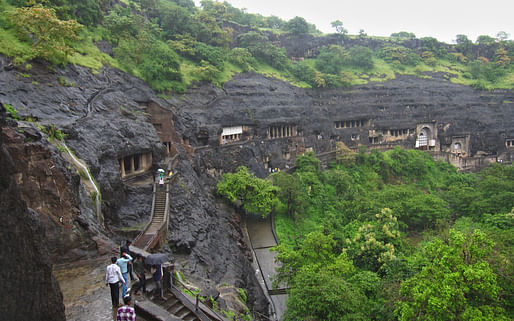
Jul '12 - Jan '13
A solid wall of rock, 200 ft tall and in my fair judgment 2,000 ft long. Bent a full 180 degrees and punctured with 30 elaborate, hand carved caves. The elders date back to the first or second century BC and are attributed to the Hinayana phase of Buddhism, and the younger from the Mahayana period of the fifth and sixth centuries.
The porticos of these portals are dwarfed from afar, stunted by the excessive amount of exposed rock face. It is only upon a more proximate evaluation that one discovers its true scale. But one may espy no Duomo here, as most caves reach no more than 13 ft in height, stretching upwards of perhaps 30 ft for the double storied prayer hall. Historical consideration, I am told, stems from the ethereal frescos adorning the walls of the early caves, and the intricate carvings of the later ones.
My euphoric gallivanting was slowed to an amble somewhere between cave 16 and 20 due to an unconscious leak of interest. It was at this time when I realized there were only two types of caves, to which I would later read about: the viharas, (monasteries), and the chaitya gribas, (prayer halls). The viharas were pillared halls, more square in plan, with an elaborate Buddha shrine, which was recessed into its own sanctuary athwart the entrance. The flanks held tiny chambers 8 ft by 10 ft with floors no more flat than the mountain they were carved into. It was here where my old monk brothers retired after their tiresomely long day, and it was in these cells where I felt a strong recollection of those 10 long days of Vipassana meditation. The chaitya gribas were loftier and elongated- showcasing a large stupa wrapped halfway in an ornately carved colonnade, creating our familiar nave and isles. There was some variety within these two typologies, but enough to hold ones astonishment and engrossment, I dare not say.
The particularities, which fondled my curiosity towards Ajanta, were of threefold. Firstly, these caves were the most pure form of subtractive architecture I have witnessed. It is graphically the strongest representation of designing space, for our habitual custom of digging holes in the sky is arcane compared to incising temples in a mountain. It requires no site plan, roof plan, or subsequent elevations. Its facade is singular and self-evident in nature, and it's structure likewise, barefaced and exposed. It is a clarity scarcely witnessed.
Secondly, the process to which these great masons meticulously and tediously chiseled through thousands of cubic ft of stone was a graphical representation of how we design. Beginning with a mass, the masons would grind around the columns creating the portico, then through the door and windows into the hall, and finally to the confines of the cells thus ending at Buddha's figure. A rough massing was chipped away, before the intricacies of the stonework were carved.
Lastly, is the lack of egotistical augmentation through hundreds of years of carving. It was not imperative for the advancement in scale or grandeur, as predecessors are often subordinate to their proceeding brethren. It seems a fitting alignment of philosophy for men who give up worldly possessions to build not for exaltation or self-gratification, but rather for the accommodation of growth.
 One may easily discern the chaitya gribas from the viharas by their façades
One may easily discern the chaitya gribas from the viharas by their façades
 A chaitya griba
A chaitya griba
 A vihara
A vihara
 The abandoned work shows its development
The abandoned work shows its development
 The common vihara colonnade
The common vihara colonnade
An Indo Inquisition is a thirteen-week train expedition across India. The journey will document the influences of international modernism and British occupation, as well as compare the effects of wealth accumulation, culture, religion, and poverty with economic growth and their effect on the built environment.
4 Comments
All three particularities are fascinating. But the freedom of "digging holes in the sky" is ultimately more liberating for architecture?
Orhan, consider these same spaces in the positive form, as masses on a plane. Would they hold the same austere clarity as their present state? Perhaps for some a clean slat poses a less intimidating design origin, though I believe restrictions beget creativity. Perhaps there are modern day mountains to which our minds may carve.
Gümüşler Monastery - Kemerhisar, Nigde, Turkey
There are many cave churches and monasteries in Turkey built by early Christians afraid of persecution. Restricted indeed. Here are some:
Kıyıköy - St. Nicholas Rock Monastery 6 th. century Justinian
http://e-turkey.net/var/albums/kirklareli_kiyikoy/kirklareli_kiyikoy_img_6655.jpg?m=1326750428
Sumela Monastery 4 th - 15 th centuries, near Trabzon (this one is partially infill and carved out of mountain)
http://www.trabzon.bel.tr/Trabzon/Tarih_Sumela/SumAl.html
Goreme. Abundant with Cave dwellings and early Chiristian churches.
http://en.wikipedia.org/wiki/Churches_of_G%C3%B6reme,_Turkey
(See also Cappadocia)
http://en.wikipedia.org/wiki/Cappadocia
These are tumbs in Likya / Fethiye
http://imgs.mi9.com/uploads/windows/2873/likya-antik-kaya-mezarlar_1920x1200_48704.jpg
Cities, modern mountains?
Interesting post, beautiful structures and set of questions about spatiality.
All great examples. Thanks for sharing. When I speak of modern mountains I mean the massive hulks of existing structures, waiting to be carved. The most local example may be the Lincoln Heights Jail, but I don't want to limit it to the dilapidated and forlorn. My thesis project attempted something of the sort. It involved the New York Federal Reserve Bank, and Hagia Sophia. You can check it out in my portfolio starting on page 73. http://www.blurb.com/books/2973771#
Block this user
Are you sure you want to block this user and hide all related comments throughout the site?
Archinect
This is your first comment on Archinect. Your comment will be visible once approved.